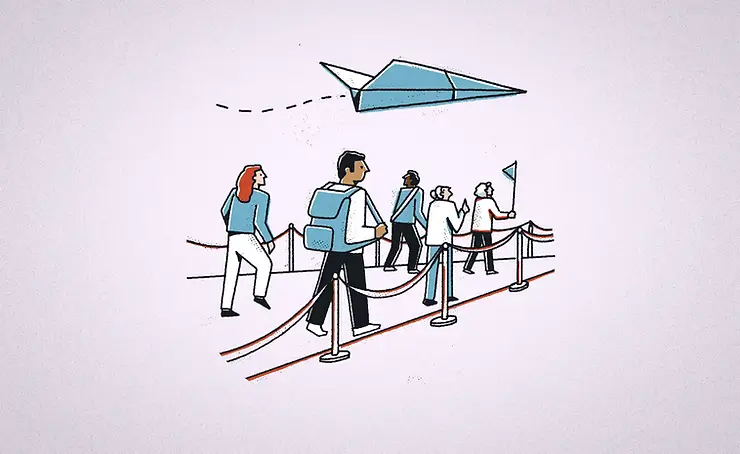It’s finally happening! Your team is meeting IRL (in real life)!
Whether you're planning a company offsite or an in-person training session, wrangling your remote or hybrid workforce can sometimes feel like herding cats. And while I love cats (and all animals for that matter), I personally don’t enjoy herding them.
At the end of this resource is a template you can use to help plan your next offsite. Hopefully it makes it easy-peasy!
Step 1: Figure out what you’re trying to achieve
Not all offsites are trying to achieve the same thing. Nor should they.
Some offsites are focused on strategic thinking:
- What company goals do we need to pursue over the next quarter?
- How do we effectively address the challenges we’re currently facing?
Others are focused on team building:
- How do we work together more effectively?
- How can we improve our sense of community and psychological safety?
And yet others are focused on improving morale and engagement:
- What achievements have we accomplished over the past year?
- What fun activities would our employees benefit from?
That isn’t to say you can’t mix and match, but if you don’t know what it is you’re optimizing for, you run the risk of missing the mark. Having a clear understanding of what you’re trying to achieve will help you better select the right exercises to pursue.
So the next time you’ve got an offsite on the horizon, ask yourself: What is that I'm optimizing for with this offsite? What am I trying to achieve?
Step 2: Figure out the structure of your company offsite
Once you know what you’re trying to accomplish, it’s time to get planning.
As obvious as this sounds, you need to start with an agenda. How many topics do you need to cover? What exercises would help you effectively tackle those topics? How long will each of those exercises take?
As you begin to map everything out, you may find that you’ll need to cut certain topics or condense the allotted time for each exercise in order to make it work. Think about how much time it would take to organize each of those sessions and who you’d need to step in as the lead for each exercise.
If it’s your first time planning an offsite, chances are: You’re going to underestimate how much time will be required for planning and execution, so I’d recommend you err on the side of caution and incorporate buffer time into everything you do. If possible, don’t schedule the event until after you’ve mapped everything out. If you’ve already committed to a particular date, you’ll need to be ruthless about prioritization, including cutting topics that aren’t absolutely necessary and finding lower lift forms of execution in order to meet whatever time constraints you’re working against.
Pro tip: Plan in breaks. Information overload is a very real thing. So make sure to schedule breaks between exercises for people to use the bathroom, check on emails, or even just go for a walk.

Step 3: Determine which groups should attend
Not all offsites need company-wide attendance. Sometimes, less is more.
Lean on the goal you’re trying to accomplish to determine who should attend. Sure, you might land on “everyone in the company.” But you could just as easily find that the offsite would be more beneficial if you limit attendance to: individual teams, executives, or even just frontline managers.
Some examples of choosing attendees based on your goals include:
- Do you need to make budget allocations and forecasting predictions for the next quarter or year? You probably just want your leadership team there.
- Is your product or engineering team in need of some inspiration for the next phase of product enhancements? You’ll probably need to plan a team-specific company offsite.
- Perhaps it’s the end of year and you’d like to celebrate the holidays, company milestones, and conduct employee recognition for top performers? This warrants a company-wide offsite.
Pro tip: While you should aim to be as equitable as possible with your offsites (i.e. if your sales team meets for an offsite, you’ll probably want to think about opportunities for other teams to meet, too), don’t try to hide offsites from other parts of the organization. The reality is, if you’re hosting an offsite for some but not others, the rest of the company is going to learn about it eventually. If you’re only hosting offsites for certain groups, this is (hopefully) because you’ve thought it through and have clear reasons that led to this decision.
Maybe there’s only enough budget to do one team offsite per year, or maybe there isn’t enough bandwidth to schedule an offsite for a larger team. Whatever your reason is, just say it. Sure, the rest of your employees might still get a bit of FOMO (fear of missing out), but at least they’ll understand your thought process rather than filling the gaps with inaccurate assumptions.
Step 4: Communicate the game plan effectively ahead of time
Planning an offsite includes a whole lot of coordination: hotel reservations, booking flights, reserving a venue (for those of you who don’t have an office or who want to meet somewhere with more affordable hotels), transportation to and from the offsite location.
It also includes a whole lot of things that might be new to your employees (and perhaps even to the company itself):
- What’s our expense policy?
- Who’s responsible for booking the flights and hotel rooms?
- Do we have any rules around COVID (i.e. vaccination or testing requirements)?
- If you have any overtime-eligible employees: What counts as paid time?
- What happens if my flights get delayed?
- Is attendance required?
- Who do I reach out to if I run into issues?
While these might seem peripheral to the offsite itself, the reality is: Communicating the answers to these questions is critical to a smooth and effective offsite. You don’t want employees panicking the night before because they didn’t realize they were supposed to book their own flights and hotel.
So make sure to send out all the details well in advance in order to avoid any unwanted surprises.
Pro tip: You don’t need to make this overly complicated. Sending out a quick FAQ that addresses all the moving pieces is a great way to stay on top of this. Just make sure to send it out far enough in advance, and add any important points you might’ve missed based on new questions that come your way.
Step 5: Remind everyone to keep it classy (Ethena trainings can help)!
We get it. Especially if you’ve been remote for a while, many of your employees may have never actually met each other in-person. They’re going to be excited to get to know each other better, share in the excitement, and let loose.
And in that environment — especially if dinner drinks are involved — it can be easy to forget that you’re still at work and that all the same rules apply.
Be proactive about sending your employees reminders on your policies and any relevant trainings. Things like a refresher on your Code of Conduct, employee handbooks, or microlessons that go over what to do at a bar or hotel, are all invaluable – and can help you keep your offsite as problem-free as possible.
(See my other post on how to keep corporate events, including happy hours, unproblematic.)
Company offsite planning template
Planning for your upcoming IRL company offsite doesn’t have to be drudgery. It can be thoughtful, invigorating, and when done right, fun!
If you’re curious how I plan our in-person company offsites at Ethena, download our How to Coordinate an In-Person Offsite Template to get started. And if you can’t send microlessons from your Code of Conduct training to employees yet – why not? Ethena can help!









